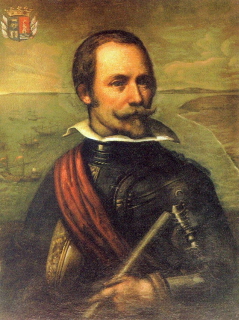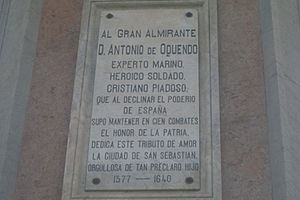Antonio de Oquendo facts for kids
Quick facts for kids
Antonio de Oquendo
|
|
|---|---|
 |
|
| Born | October 1577 San Sebastián, Guipúzcoa |
| Died | 7 June 1640 A Coruña |
| Allegiance | Spain |
| Service/ |
Spanish Navy |
| Years of service | 1594-1640 |
| Rank | Captain General |
| Battles/wars | |
| Relations | Miguel de Oquendo (father) |
Antonio de Oquendo y Zandategui (born October 1577 in San Sebastián, Guipúzcoa – died June 7, 1640, in A Coruña) was an important Spanish admiral. He is best known for leading the Spanish forces during the Battle of the Downs in 1639.
Contents
Antonio de Oquendo followed in his father's footsteps. His father, Miguel de Oquendo, was also a high-ranking naval officer. Sadly, his father died in 1588 when his ship sank after a difficult campaign.
In 1594, Antonio joined the navy. He quickly rose through the ranks. He commanded a group of ships that included his main ship, the Delfín de Escocia. On August 7, 1604, he successfully captured an English private ship that attacked other ships. This happened during the Battle of the Gulf of Cádiz. At this time, he was part of Admiral Luis Fajardo's fleet.
Leading Fleets and Facing Challenges
In 1607, Antonio was put in charge of the Biscay squadron. This was a group of ships from the Biscay region of Spain. This squadron was later made bigger and renamed the squadron of the Bay of Biscay. In the same year, he also became the General of the Fleet for the Viceroyalty of New Spain. This meant he was in charge of ships that sailed to and from Spanish lands in the Americas.
Later, Antonio de Oquendo faced some difficulties. In 1619, he temporarily took over command of the main fleet for the Atlantic Ocean. The previous commander had been arrested for not following orders. Antonio refused to take the job permanently. He tried to tell the government about problems with the navy's organization. Because of this, he was put in prison for a short time. After a while, he was released and given command of the yearly Spanish treasure fleet. These were ships that carried silver and other valuable goods from the Americas to Spain.
In 1624, Antonio was accused of wrongdoing. However, he was able to prove that these accusations were made up by his enemies in the fleet. Even so, he was not allowed to command the treasure fleet for four years. He also had to pay a large fine because two of his ships were lost near Cuba.
Rising to the Top Rank
In 1626, De Oquendo became Admiral-General of the Ocean Fleet. This was a very important position. In 1628, he took action on his own to help a Spanish fort called La Mámora. It was being attacked by the Moors, and he successfully helped defend it.
In 1631, he led a group of ships carrying soldiers to Brazil. Their mission was to take back the city of Pernambuco. The Dutch West India Company had captured this city the year before. On September 12, he fought and defeated a Dutch fleet. This allowed the Spanish soldiers to land safely. The Spanish lost one ship, but the Dutch lost three. After this important victory, De Oquendo was promoted to the highest rank: Captain-General.
In 1636, he faced more personal trouble. He was arrested for fighting an Italian nobleman. In 1637, he refused to send his ships to help the fleet of the Kingdom of Naples. He said his squadron did not have enough sailors or supplies. As a punishment, he was made governor of Mahón, a city on the island of Menorca.
The Battle of the Downs
In 1639, Spain was having a tough time in the Thirty Years War. France had blocked a key land route used by the Spanish army. This meant that Spanish soldiers and supplies had to be sent by sea. In August, De Oquendo was given a new title and put in charge of a large fleet. His job was to transport soldiers and supplies from Cadiz to Dunkirk.
On September 15, his fleet was met by a Dutch squadron near the Strait of Dover. The Dutch fleet was led by Lieutenant-Admiral Maarten Tromp. Two days later, more Dutch ships joined them. Even though the Dutch had fewer ships, they were very skilled. They used a clever battle strategy to badly damage the larger Spanish ships.
De Oquendo worried that if he sailed into the narrow channel to Dunkirk, his fleet would be trapped. So, he decided to seek safety in The Downs. This was a neutral area in English waters. He hoped to move his soldiers to Flanders using English ships. However, on October 31, the Dutch fleet, which had grown much larger, attacked the Spanish fleet. They did not respect the neutral English waters. The Dutch succeeded in destroying or capturing many Spanish ships.
De Oquendo himself managed to escape, but he was badly hurt and very discouraged. He never fully recovered from this defeat. After returning to Spain, he died soon after in A Coruña.
See also
 In Spanish: Antonio de Oquendo para niños
In Spanish: Antonio de Oquendo para niños



